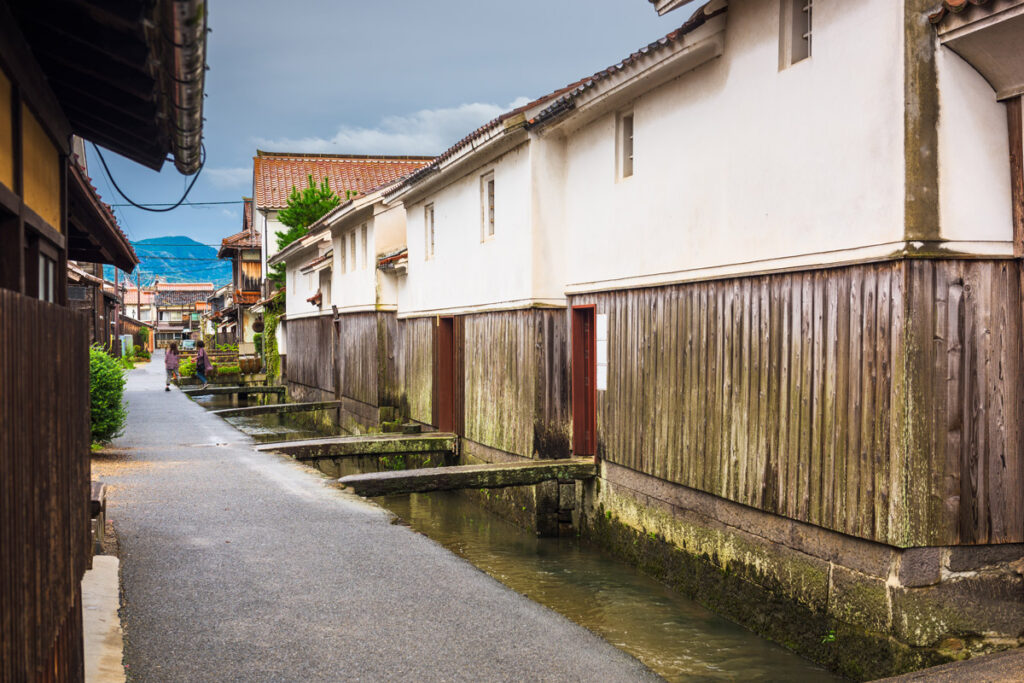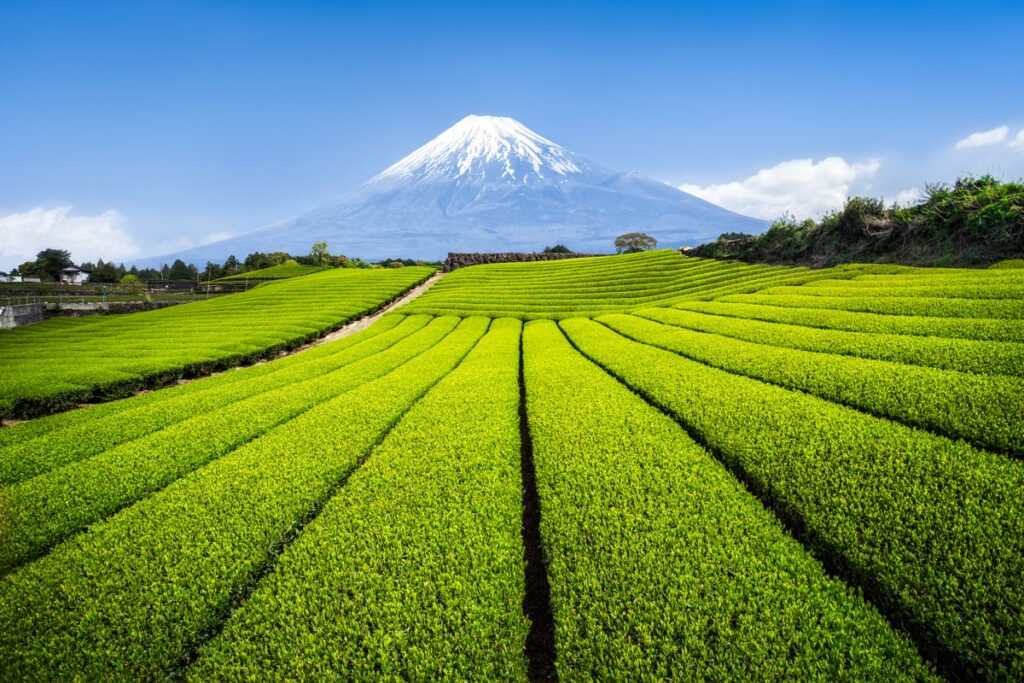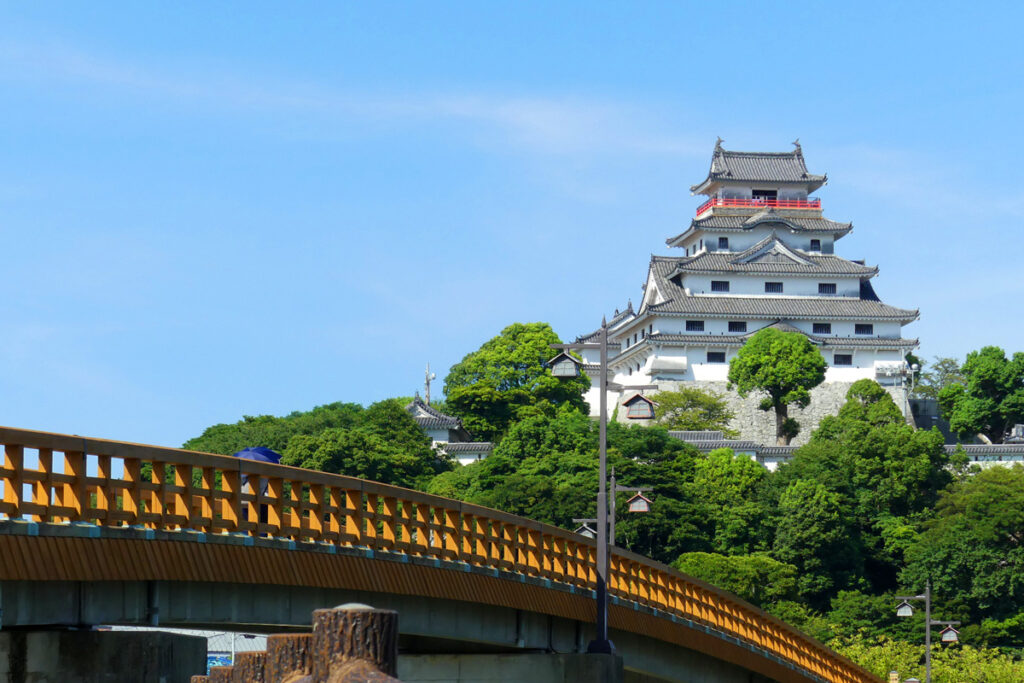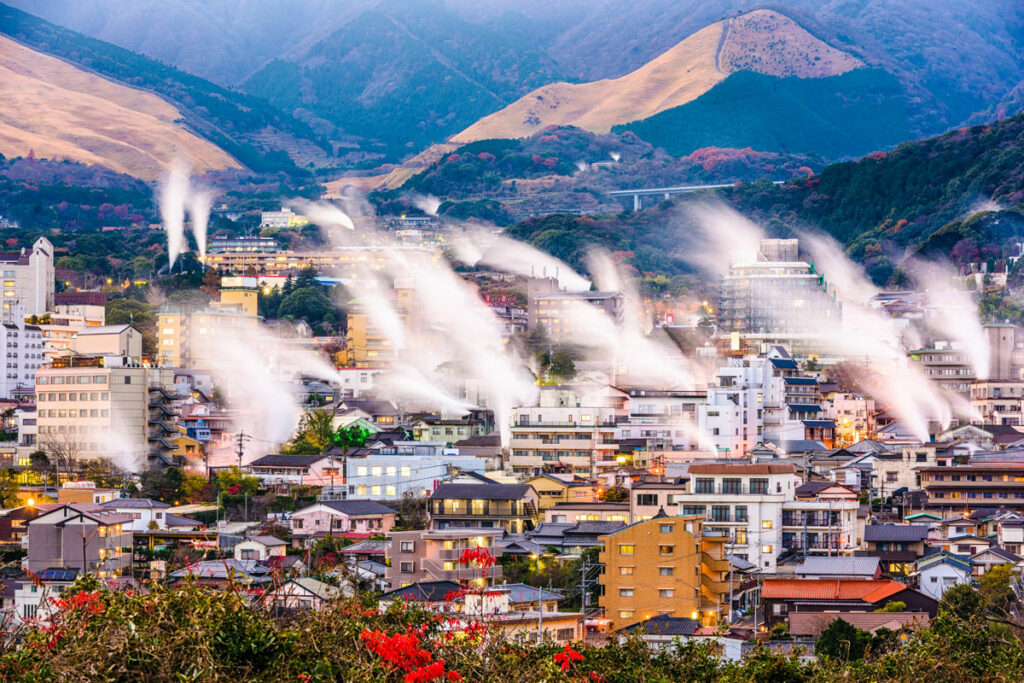Kyoto, nestled within the verdant embrace of the Kansai Region‘s hills, serves as a vivid tapestry of Japan’s rich heritage and the seamless blend of its past with the present. This ancient capital, a jewel in Kyoto Prefecture, lies at the heart of Japan’s cultural and historical narrative, offering a tranquil retreat from the bustling pace of Tokyo. As a city that has elegantly preserved its architectural marvels, Kyoto invites travelers to wander through time, exploring its serene temples, majestic shrines, and lush bamboo forests.
Embarking on a journey through Kyoto is like leafing through the pages of a history book, where each site narrates a tale of the city’s glorious past. From the iconic Kiyomizu Dera, offering panoramic views of the city, to the mesmerizing paths lined with torii gates at Fushimi Inari Taisha, Kyoto is a mosaic of cultural and natural wonders. The city’s vibrant streets, such as the historic Hanamikoji Street, and bustling markets like Nishiki, offer a glimpse into the daily lives of its residents, providing a vivid contrast to the serene beauty of its natural attractions, such as the Arashiyama Bamboo Forest.
Beyond the allure of its attractions, Kyoto is a city deeply rooted in tradition, where the ancient practices of tea ceremonies and the arts of the geisha continue to thrive, offering visitors a unique insight into Japanese culture. The city’s proximity to Nara and Osaka further enriches the travel experience, allowing for easy exploration of the Kansai Region’s diverse offerings.
Let this guide be your compass to the 12 best things to do in Kyoto Japan, where every corner turned unfolds a new chapter in the story of this enchanting city, making it a must-visit destination on your travel itinerary.
Where to Stay in Kyoto: Top Rated Accommodations
1. Kiyomizu Dera
This iconic temple is one of the most popular tourist destinations in Kyoto. Perched on a hill, it offers stunning views of the city and is a great place to start your sightseeing tour.
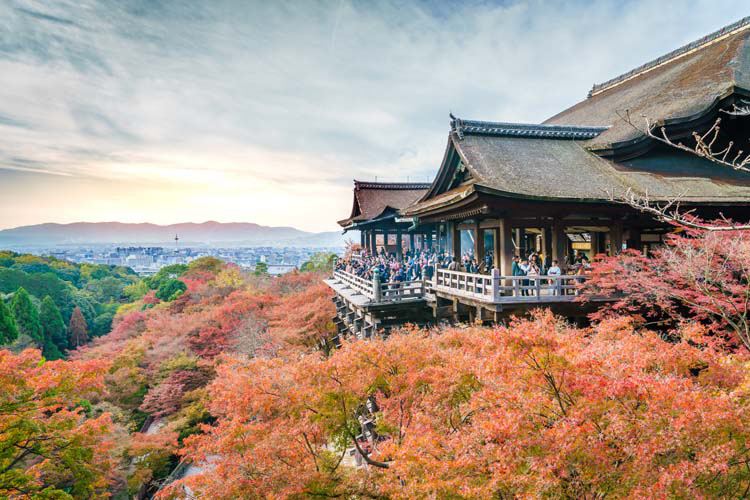
Kiyomizu Dera, Perched on the side of a mountain, It is not just a temple; it’s a testament to Kyoto’s spiritual and architectural splendor. The main hall, jutting out over the hillside, offers a stunning view that will make your heart skip a beat – especially during cherry blossom season or autumn when the scenery is just out of a storybook.
But there’s more to Kiyomizu Dera than just pretty views. The temple is steeped in history, dating back to 780 AD. Walking through the temple grounds feels like a journey through time. You’ll see the famous “Jishu Shrine,” dedicated to the deity of love and matchmaking. Here’s a fun challenge: close your eyes and walk between the two love stones placed 18 meters apart. It’s said that if you can walk from one stone to the other with your eyes closed, your love wish will come true.
And let’s not forget the Otowa Waterfall, where three streams of water fall into a pond. Each stream is believed to bestow different benefits – longevity, success at school, and a fortunate love life. So, take a sip and let the magic work!
Visiting Kiyomizu Dera is more than just ticking off a tourist attraction; it’s about embracing the tranquility and the rich cultural tapestry of Kyoto.
Official Website: Kiyomizu Dera
Address: 1 Chome-294 Kiyomizu, Higashiyama Ward, Kyoto, 605-0862
For Reviews Visit: TripAdvisor
2. Fushimi Inari Taisha
This shrine is famous for its thousands of red torii gates that lead up to the top of Mount Inari. The path is lined with food stalls, offering visitors a chance to sample local cuisine.
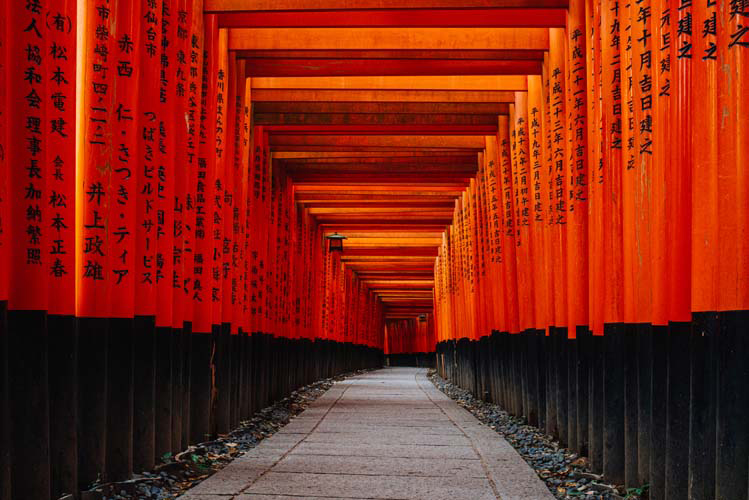
Fushimi Inari Taisha is one of the most famous shrines in Kyoto, Japan and a must-visit destination for any traveler to the city. Famous for its thousands of vermilion torii gates, this shrine is a sight to behold and a dream for photographers and spiritual seekers alike.
As you step into this sacred space, you’re not just visiting another tourist attraction; you’re entering a realm where every corner tells a story. The shrine is dedicated to Inari, the Shinto god of rice, and you’ll see numerous fox statues, considered the messengers of Inari. The vibrant torii gates, snaking up the Mount Inari, create a mesmerizing path, leading you through a captivating, vermilion tunnel. It’s an experience that feels almost otherworldly.
The hike to the summit of the mountain and back is about 2-3 hours, but it’s worth every step. Along the way, you’ll come across smaller shrines, tea houses, and spots offering breathtaking views of Kyoto. It’s a journey that perfectly blends spiritual fulfillment with physical exertion.
Visiting Fushimi Inari Taisha is more than just checking off a shrine from your Kyoto list. It’s about feeling the pulse of ancient traditions, understanding the depth of Japanese culture, and maybe, just maybe, finding a piece of yourself along those sacred paths. Whether you’re here for the culture, the hike, or the gram, Fushimi Inari Taisha is a must-see that truly embodies the spirit of Kyoto.
Official Website: Fushimi Inari Taisha
Address: 68 Fukakusa Yabunouchicho, Fushimi Ward, Kyoto, 612-0882
For Reviews Visit: TripAdvisor
3. Nishiki Market
This historic market is a food lover’s paradise. With over 100 shops selling everything from traditional Japanese sweets to fresh seafood, it’s a great place to wander and try some local specialties.
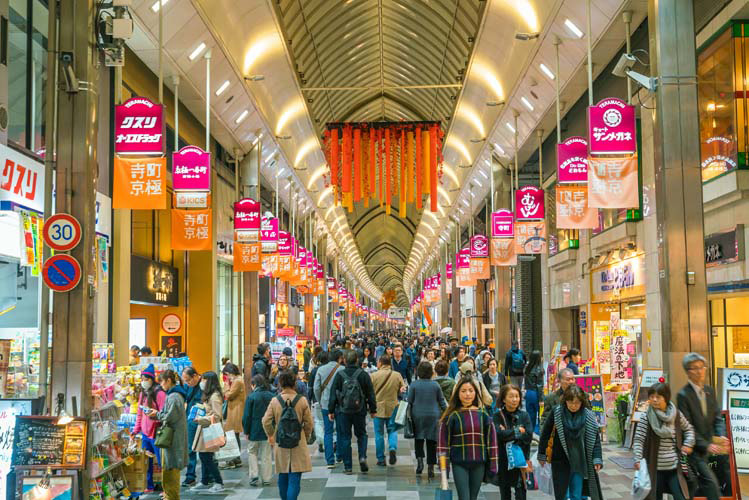
Nishiki Market, also known as Kyoto’s Kitchen, is a must-visit destination for any food lover traveling to Kyoto, Japan. This narrow, five-block-long shopping street is a sensory overload in the best way possible – filled with sights, sounds, and irresistible smells that make it a paradise for foodies and curious travelers alike.
As you stroll through the market, you’ll encounter over a hundred shops and stalls, each offering a glimpse into Kyoto’s culinary culture. From fresh seafood to seasonal sweets, pickled vegetables to exquisite spices, the market is a treasure trove of all things delicious. Don’t miss out on tasting some local specialties like Kyoto pickles, known as tsukemono, and the tantalizingly fresh sashimi.
But Nishiki Market isn’t just about the food. It’s a vibrant showcase of Kyoto’s living traditions. You’ll see local artisans at work, crafting everything from handmade knives to traditional Japanese sweets. The market is also a fantastic place to buy unique souvenirs, like beautiful Kyoto ceramics or Japanese tea.
What makes Nishiki Market stand out is its lively atmosphere. It’s not just a market; it’s a social hub where locals and tourists come together, a place where every alley and stall has a story to tell. Whether you’re here to sample the local flavors, learn about Kyoto’s culinary heritage, or simply soak up the lively vibes, Nishiki Market is an unmissable experience in the heart of Kyoto.
Official Website: Nishiki Market
Address: Nakagyo Ward, Kyoto, 604-8055
For Reviews Visit: TripAdvisor
4. Nijo Castle
This castle, built in 1603, was the residence of the Tokugawa shoguns during their rule in Japan. Today, it’s a museum that showcases the history of the era and is a must-visit for history buffs.
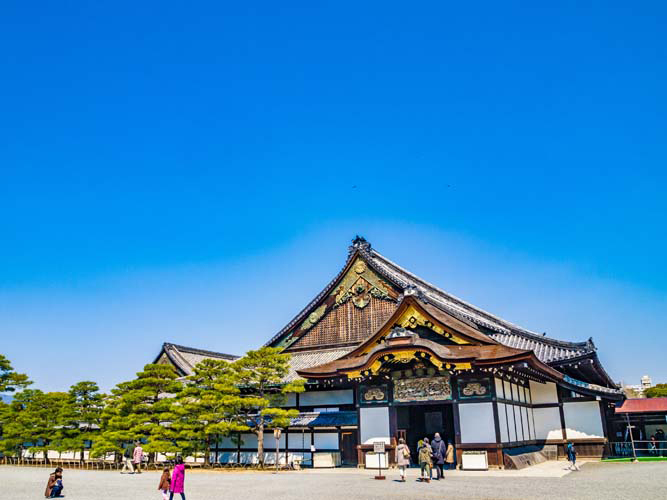
Nijo Castle is a magnificent example of traditional Japanese architecture and a must-visit destination for anyone traveling to Kyoto, Japan. As you step through its massive gates, you’re entering a world that once buzzed with samurai and shoguns.
Built in 1603, Nijo Castle served as the Kyoto residence of the Tokugawa Shoguns. Its grandeur is evident in every aspect, from the imposing stone walls to the lavish interiors. The main building, Ninomaru Palace, is famous for its “nightingale floors,” designed to chirp when walked upon, alerting residents to any intruders – a clever ancient security system!
As you wander through the ornate rooms, adorned with beautifully detailed, gold-leafed screen paintings, you’ll feel the aura of the Edo period. The castle’s gardens are a masterpiece themselves, offering a serene escape with their meticulously manicured landscapes, reflecting ponds, and blooming cherry trees in spring.
Visiting Nijo Castle isn’t just about admiring a beautiful garden or an impressive building; it’s about immersing yourself in a pivotal part of Japan’s history. It’s a place that eloquently narrates tales of power, politics, and artistry. Whether you’re a history enthusiast or just someone who appreciates beauty in all its forms, Nijo Castle is a captivating experience that showcases the essence of Kyoto’s past.
Official Website: Nijo Castle
Address: 541 Nijojocho, Nakagyo Ward, Kyoto, 604-8301
For Reviews Visit: TripAdvisor
5. Bamboo Forest Kyoto
This stunning forest is a peaceful oasis in the heart of the city. With towering bamboo trees swaying in the breeze, it’s a great place to escape the hustle and bustle and enjoy some tranquility.
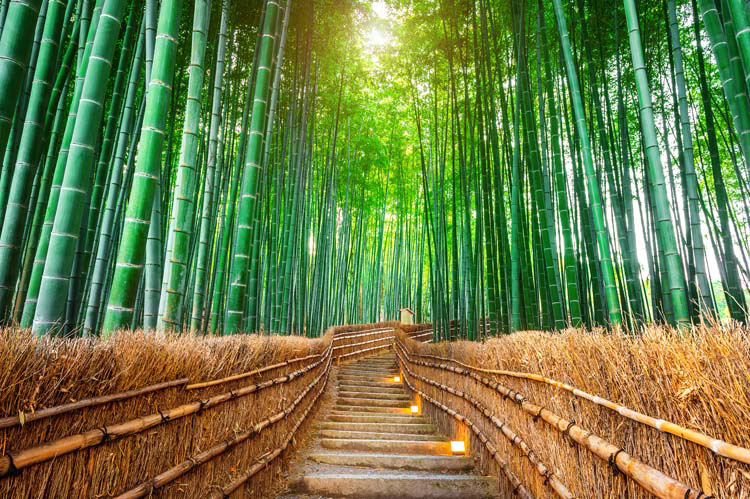
Imagine walking through towering stalks of bamboo, their leaves whispering in the wind, casting dancing shadows on the path – this is the Bamboo Forest Kyoto, a natural wonder that feels like something straight out of a fairytale. Located in Arashiyama, a scenic area on the outskirts of Kyoto, this bamboo grove is a symbol of tranquility and natural beauty.
The experience of walking through the Bamboo Forest is both surreal and calming. The path, surrounded by these soaring green stalks, creates a serene canopy that filters the sunlight into a soft, green glow. It’s a photographer’s dream and a nature lover’s paradise. The sound of the bamboo swaying in the breeze is so distinctive that it’s been designated as one of the “100 must-be-preserved sounds of Japan.”
But the Bamboo Forest is more than just a pretty sight. It’s a testament to the deep connection between Japanese culture and nature. Bamboo is an integral part of Japanese life, used in everything from construction to craft-making. As you walk through the grove, you’re not just in a beautiful garden; you’re in a living, breathing part of Japanese heritage.
Whether you visit early in the morning to avoid the crowds or catch the golden light of the afternoon, the Bamboo Forest Kyoto offers a moment of peace and a break from the bustling city life. It’s a must-visit for anyone seeking a moment of zen and one of the most iconic attractions in Kyoto.
Official Website: Bamboo Forest Kyoto
Address: Sagaogurayama Tabuchiyamacho, Ukyo Ward, Kyoto, 616-8394
For Reviews Visit: TripAdvisor
6. Kyoto Tower
This observation tower offers panoramic views of the city from its top floor. It’s a great place to go for a bird’s-eye view of Kyoto and take some unforgettable photos.
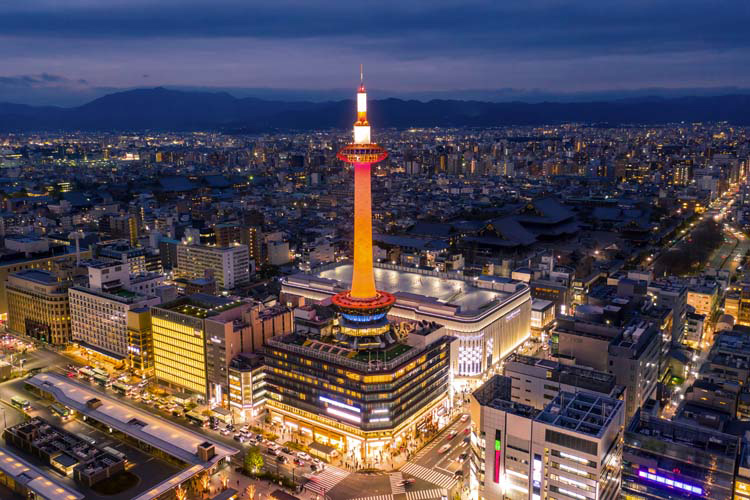
Kyoto Tower is a beacon of modernity in the historically rich Kyoto. This towering structure, which stands at 131 meters tall, offers a unique contrast to the traditional architecture that Kyoto is famed for. It’s not just a tower; it’s a symbol of the city’s blend of the old and the new.
As you step into Kyoto Tower, you’re treated to a panoramic view that is second to none. The observation deck, perched 100 meters above the ground, provides a 360-degree view of Kyoto and beyond. On a clear day, you might even catch a glimpse of Osaka in the distance. It’s the perfect spot to get your bearings in the city and appreciate its layout, nestled among mountains and threaded with rivers.
But the experience of Kyoto Tower extends beyond just enjoying the view. The tower also houses a variety of shops, restaurants, and even a public bathhouse on its lower floors. It’s a one-stop destination for those looking to shop, dine, or just unwind after a day of sightseeing.
Visiting Kyoto Tower offers a moment to reflect on Kyoto’s journey through time. While the city honors its past, it also embraces the future, and this tower is a testament to that. Whether you’re snapping photos from the observation deck, browsing through souvenirs, or soaking in the bathhouse, Kyoto Tower is a unique blend of Kyoto’s tradition and modernity, making it a must-visit attraction in the heart of the city.
Official Website: Kyoto Tower
Address: 721-1 Higashishiokojicho, Shimogyo Ward, Kyoto, 600-8216
For Reviews Visit: TripAdvisor
7. Kinkakuji
Kinkakuji Temple – Also known as the Golden Pavilion, this temple is covered in gold leaf and is one of Kyoto’s most famous landmarks. It’s a beautiful and serene place to visit and is surrounded by stunning gardens.
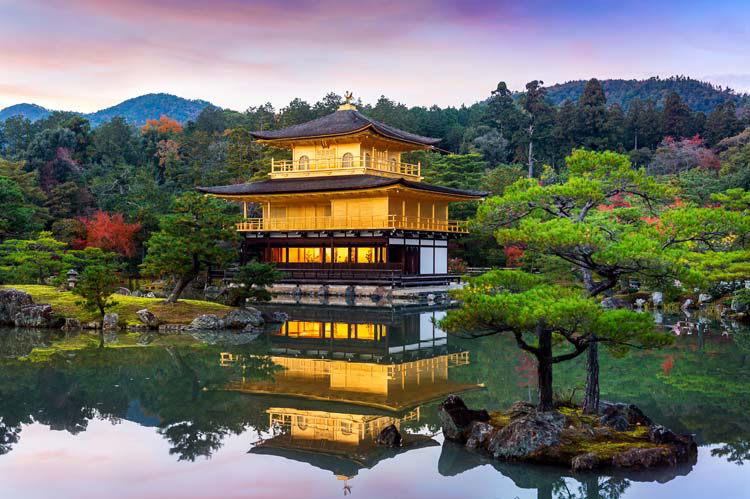
Kinkakuji, also known as the Golden Pavilion, is a spectacle of opulence and tranquility, a masterpiece that truly embodies the spirit of Kyoto. This Zen temple, covered in brilliant gold leaf, shimmers alongside a tranquil pond, creating a scene that looks like it’s been lifted from a dream.
Originally a shogun’s villa, Kinkakuji was transformed into a Zen temple after his death. The gold covering, which gives the temple its fame, isn’t just for show; it symbolizes purification from negative thoughts and feelings. The reflection of the pavilion in the pond, known as Kyoko-chi (Mirror Pond), adds to the magical aura, creating a scene of breathtaking beauty.
Walking around the garden surrounding Kinkakuji is a serene experience. The carefully landscaped grounds, featuring a harmonious blend of rocks, water, and vegetation, are a fine example of Muromachi-period garden design. The changing seasons bring new colors and moods to the garden, making every visit unique.
Visiting Kinkakuji is more than just a chance to see one of Kyoto’s most famous attractions; it’s an opportunity to experience the peacefulness of Zen philosophy and appreciate the artistry of Japanese garden design. Whether bathed in the golden light of summer or adorned with a dusting of snow in winter, Kinkakuji is a must-see for anyone exploring the rich cultural tapestry of Kyoto.
Official Website: Kinkakuji
Address: 1 Kinkakujicho, Kita Ward, Kyoto, 603-8361
For Reviews Visit: TripAdvisor
8. Hanamikoji Street
This street is famous for its traditional tea houses, which offer visitors a chance to experience a traditional tea ceremony. It’s a great place to wander and soak up the atmosphere.
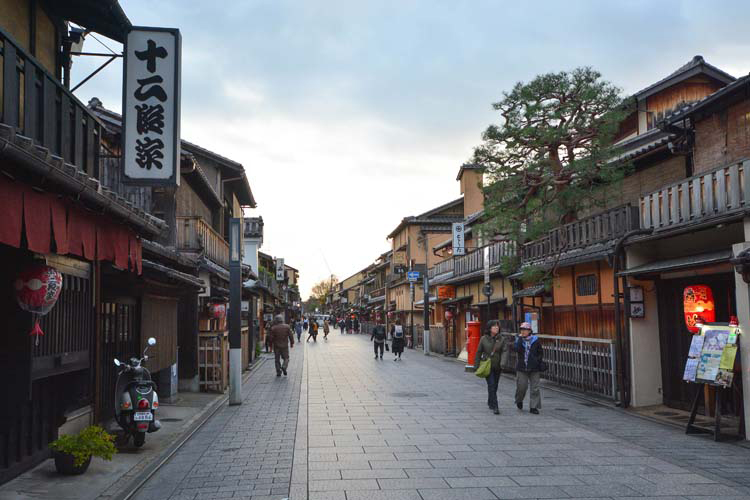
Walking down Hanamikoji Street in Gion is like stepping into a living painting of old Kyoto. This historic street, located in the heart of Kyoto’s most famous geisha district, Gion, is a beautifully preserved window into the city’s past. With its traditional wooden machiya houses, exclusive ochaya (tea houses), and lantern-lit evenings, Hanamikoji is a must-visit for anyone looking to experience the Kyoto of yore.
As you stroll through Hanamikoji, the charm of Kyoto’s history envelops you. The street is not just a place; it’s a narrative of Japan’s cultural heritage. You might catch a glimpse of geiko (Kyoto dialect for geisha) or maiko (apprentice geisha) in their exquisite kimonos and elaborate hairstyles, hurrying to their next appointment. These elegant figures are the living embodiments of Japanese arts and traditions, making Gion a unique cultural enclave.
The area is also famous for its traditional tea houses and high-end ryotei (Japanese restaurants), where guests can enjoy kaiseki (multi-course meals) and performances by maiko and geiko. Though many of these establishments are exclusive and require an introduction from a regular client, there are also places where tourists can enjoy geisha performances and learn about this fascinating aspect of Japanese culture.
Exploring Hanamikoji Street offers a glimpse into a side of Kyoto that remains untouched by time. It’s a place where the past and present coexist, offering visitors a chance to connect with the traditions that have shaped Kyoto’s identity. A walk down this iconic street is not just a walk through a neighborhood; it’s a journey through the heart of Kyoto’s cultural legacy.
Address: Gionmachi Minamigawa, Kyoto, 600-8340
For Reviews Visit: TripAdvisor
9. Arashiyama Monkey Park Iwatayama
This park is home to over 120 wild monkeys, who roam freely and interact with visitors. It’s a unique and entertaining experience and a great place to observe these fascinating creatures.
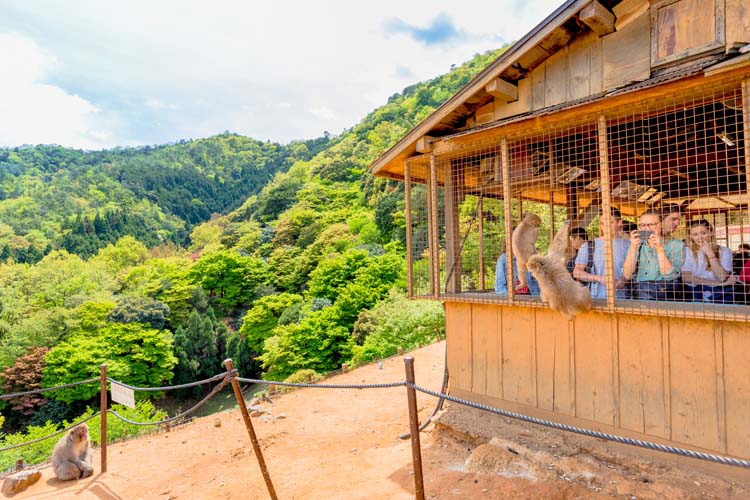
Nestled in the scenic district of Arashiyama, Arashiyama Monkey Park Iwatayama presents a delightful escape into the world of wildlife, offering a unique experience quite unlike any other in Kyoto. This park, home to a troop of over 120 Japanese macaque monkeys, is not just an attraction but an adventure into the natural world.
The journey begins with a bit of a hike up the hillside, but the effort is rewarded manifold. As you ascend, take a moment to enjoy the picturesque views of Kyoto and the surrounding mountains – it’s a panorama that’s as breathtaking as it is serene. Once at the top, you’re greeted by the friendly and free-roaming macaques, known for their playful nature and fascinating social interactions.
At Arashiyama Monkey Park Iwatayama, you can observe the monkeys in their natural habitat, a rare and educational experience. Unlike typical zoos, here the monkeys are not in cages, and it’s the humans who can enter a small hut to feed them. This unique setup allows for an up-close encounter with these intriguing animals, providing insights into their behavior and hierarchy.
The park also serves as an excellent spot for families and nature enthusiasts. It’s not only about watching monkeys but also about connecting with nature and learning about wildlife conservation. Whether you’re a photographer looking to capture some candid monkey moments or a family seeking a fun and educational outing, Arashiyama Monkey Park Iwatayama offers an experience that is both enjoyable and enlightening.
Official Website: Arashiyama Monkey Park
Address: 〒616-0004 Kyoto, Nishikyo Ward, Arashiyama Nakaoshitacho, 61
For Reviews Visit: TripAdvisor
10. Kyoto National Museum
This museum showcases the rich cultural heritage of Kyoto and is a must-visit for anyone interested in Japanese history and art.
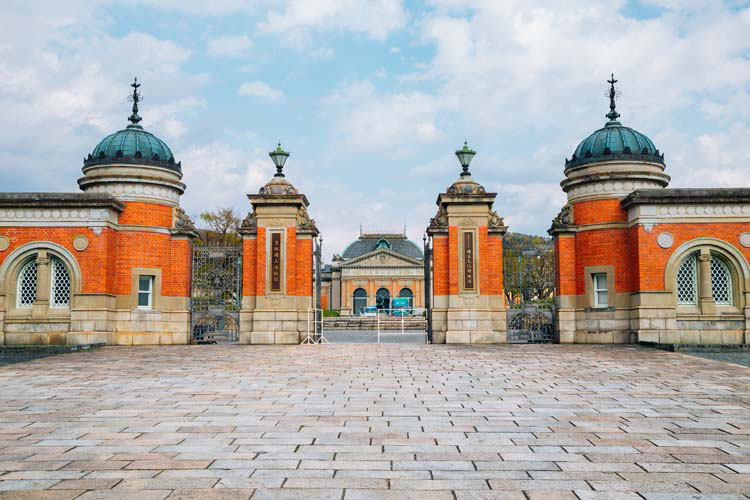
For art lovers and history enthusiasts, a visit to the Kyoto National Museum is an unmissable experience. This museum, one of Japan’s most prominent, is a treasure trove of Japanese art and cultural artifacts that offer a deep dive into the nation’s rich heritage. Located in the Higashiyama district, near some of Kyoto’s famous temples, the museum beautifully complements the historical exploration of the city.
The museum’s collection is vast and varied, encompassing everything from ancient pottery and Buddhist sculptures to delicate textiles and exquisite paintings. The main building, known as Meiji Kotokan, is an architectural marvel in itself, blending traditional and modern design elements. The exhibitions are well-curated, often including interactive elements that bring the history and culture of Japan to life in a way that’s both engaging and educational.
What sets the Kyoto National Museum apart is its focus on the art and history of Kyoto and the surrounding Kansai region. It’s a place where you can immerse yourself in the world of samurai, explore the subtleties of Japanese tea ceremony utensils, or marvel at the intricate details of a kimono. Special exhibitions, which change regularly, offer a chance to see rare items and thematic displays that delve deeper into specific aspects of Japanese art and culture.
A visit here isn’t just about viewing artifacts; it’s about gaining a deeper understanding of the aesthetics, history, and cultural significance behind each piece. Whether you’re a first-time visitor to Japan or a long-time aficionado of Japanese culture, the Kyoto National Museum offers a rich, insightful experience that adds depth to your Kyoto journey.
Official Website: Kyoto National Museum
Address: 527 Chayacho, Higashiyama Ward, Kyoto, 605-0931
For Reviews Visit: TripAdvisor
11. Kyoto Railway Museum
This museum, located in an old railway station, showcases the history of Japanese rail transport and is a great place for families and train enthusiasts.
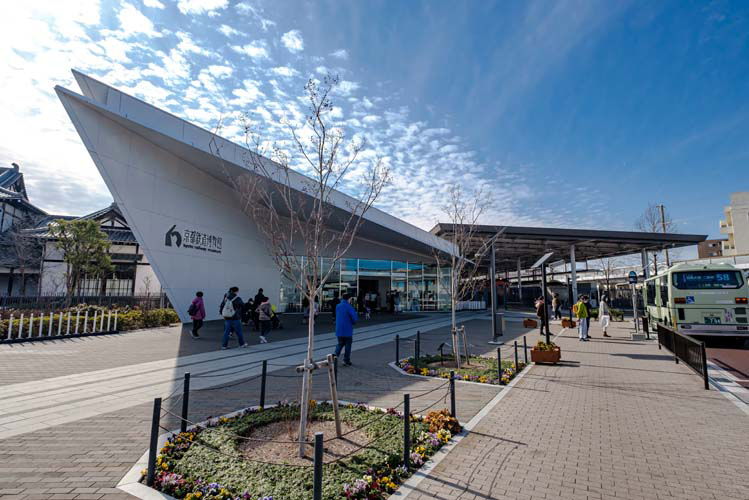
The Kyoto Railway Museum is a unique and fascinating destination for visitors to Kyoto, Japan. This museum, which is dedicated to the history and technology of trains and rail transportation, is a must-visit destination for anyone with an interest in trains, technology, or the history of transportation.
All aboard for a journey through Japan’s impressive railway history at the Kyoto Railway Museum! This museum is not just for train enthusiasts; it’s a captivating exploration of the evolution of rail travel in Japan, showcasing how it has shaped the nation’s history and culture. Located conveniently near Kyoto Station, this museum is a must-visit for families, history buffs, and anyone curious about the world of trains.
As you enter the museum, you’re greeted by a vast collection of locomotives and carriages, ranging from steam engines to the modern-day shinkansen (bullet trains). The exhibits are thoughtfully displayed, allowing visitors to get up close and even step inside some of the trains. It’s a rare opportunity to see the inner workings of these engineering marvels and understand the technological advancements over the years.
One of the highlights of the Kyoto Railway Museum is the train simulator, where you can experience what it’s like to drive a shinkansen. It’s an exhilarating experience that combines education and entertainment. For younger visitors, there are interactive areas where they can play and learn about trains in a fun, engaging environment.
The museum also offers insights into the life of railway workers, the evolution of railway stations, and the impact of trains on society and everyday life in Japan. It’s a comprehensive and immersive experience that provides a unique perspective on Japan’s renowned railway system. Whether you’re marveling at the classic steam engines or exploring the sleek shinkansen, a visit to the Kyoto Railway Museum is a journey through time and technology, offering a fascinating glimpse into a vital part of Japan’s identity and progress.
Official Website: Kyoto Railway Museum
Address: Kankijicho, Shimogyo Ward, Kyoto, 600-8835
For Reviews Visit: TripAdvisor
12. Kyoto Aquarium
This aquarium is home to a wide range of marine life, including penguins, seals, and a variety of fish. It’s a great place to spend a few hours and learn about the ocean and its inhabitants.
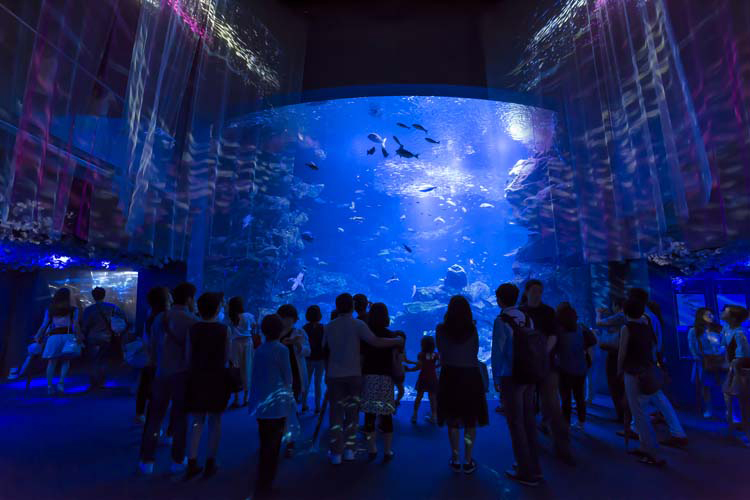
Dive into a world of aquatic wonder at the Kyoto Aquarium, a modern facility that brings the mysteries of the ocean to the heart of this ancient city. Located in the Umekoji Park area, close to Kyoto Station, the aquarium is a perfect family-friendly destination that offers both entertainment and education about marine life.
The Kyoto Aquarium is notably comprehensive in its exhibits, showcasing a wide range of aquatic habitats from the local rivers of Kyoto to the vast Pacific Ocean. One of the highlights is the large tank that simulates the Kyoto river system, providing a unique glimpse into the underwater ecosystem right in Kyoto’s backyard. It’s a beautiful blend of local culture and natural history, illustrating the connection between the city and its surrounding waters.
Another must-see exhibit is the dolphin pool, where visitors can watch these playful creatures in action. The aquarium hosts regular dolphin shows, which are not only entertaining but also educational, emphasizing the importance of marine conservation and the intelligence of these marine mammals.
For those interested in the more unusual marine life, there are also tanks dedicated to jellyfish, showcasing their ethereal beauty in a mesmerizing display. The touch pools, where you can interact with some of the sea creatures, are a hit with children, providing a hands-on learning experience.
Visiting the Kyoto Aquarium is more than just an opportunity to see marine animals; it’s an educational journey into the aquatic world. With its focus on conservation and connection to the local environment, the aquarium offers a deeper understanding of the importance of preserving our oceans and rivers, making it a valuable and enjoyable visit for all ages.
Official Website: Kyoto Aquarium
Address: 梅小路公園, 内, 35-1 Kankijicho, Shimogyo Ward, Kyoto, 600-8835
For Reviews Visit: TripAdvisor
Frequently Asked Questions
What are some top things to do in Kyoto?
Kyoto offers a lot of unique and enchanting experiences. Some of the top things to do include visiting the beautiful temples in Kyoto, strolling through Gion, catching the cherry blossoms in spring, exploring Toei Kyoto Studio Park, and visiting the Kyoto International Manga Museum. The city also offers various traditional Japanese cooking classes.
What are some must-see attractions in Kyoto?
Kyoto is one of the best places to experience traditional Japanese culture. Some must-see attractions include the Kyoto Imperial Palace, Kinkaku-ji Temple, Nanzen-ji Temple, the Philosopher’s Path, and the historic district of Gion. Kyoto Botanical Garden is also a must-see, especially during the cherry blossom season.
Where can I experience traditional Japanese culture in Kyoto?
A: Kyoto is one of the best places to experience traditional Japanese culture. The district of Gion, known for its traditional Japanese tea houses and the world renown geisha culture, is a great start. You can also visit the numerous beautiful temples and shrines, especially in Eastern Kyoto. Toei Kyoto Studio Park also provides a fun experience geared towards traditional Japanese cinema.
What’s the best time to enjoy the cherry blossoms in Kyoto?
The cherry blossoms, known as “sakura” in Japan, usually bloom from the end of March to mid-April. It’s one of the most famous scenes in Kyoto, with the temples, parks, and even streets lined with these beautiful blossoms. Some of the best spots include the Kyoto Botanical Garden and the Philosopher’s Path.
What can I do around Kyoto Station?
Kyoto Station is not just a transport hub, it’s a tourist destination itself. There are numerous attractions nearby, including the Kyoto Tower, Higashi Honganji Temple, and Kyoto Aquarium. The station building itself is home to a variety of shops, restaurants, and even a theater. It’s a must-see part of Kyoto.
Can you recommend a good day trip from Kyoto?
AYes, the city of Nara makes a great day trip from Kyoto. It houses some of Japan’s most important temples and has a charming park where deer roam freely. You can easily reach Nara by train, with your Japan Rail Pass.
Where are the most beautiful gardens in Kyoto?
Kyoto is famed for its beautiful gardens. The Shosei-en Garden, located in Central Kyoto, is an oasis of peace with its tranquil pond and meticulously pruned trees. The garden in the Ginkaku-ji Temple is an example of a traditional Japanese sand garden, and the Kyoto Botanical Garden is home to a huge variety of plant species.
What is there to do in the northern part of Kyoto?
Northern Kyoto, less crowded compared to other parts of the city, offers several attractions. The Golden Pavilion (Kinkaku-ji) and the Silver Pavilion (Ginkaku-ji) are two major must-see spots in Northern Kyoto. The region is also home to some beautiful temples, shrines, and gardens. It’s also where you can find the famous Philosopher’s Walk.
Are there any cooking classes available in Kyoto?
Yes, there are numerous cooking classes available in Kyoto where you can learn to prepare traditional Japanese dishes. You can try your hand at making sushi, ramen, or even matcha tea. Checking online reviews is a good way to decide which one suits you best.
Where can I find more Kyoto travel guide information?
There’s plenty of information available online. The official Kyoto Travel Guide website is a good place to start. It provides a comprehensive guide to the city, including sightseeing spots, restaurants, events, and more. Other travel websites and blogs also provide deep insights and reviews about Kyoto tourist attractions.

